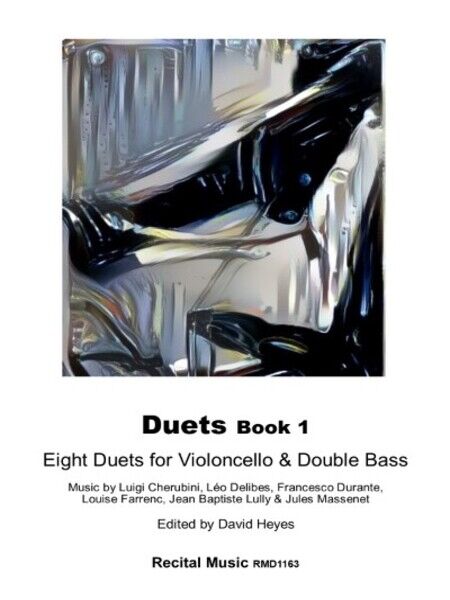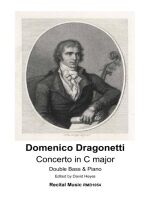Duets Book 1

Product code:
£12.50
Description
Duets Book 1 is a collection of eight accessible and fun duets for the intermediate cello and double bass duo. Ideal as recital repertoire or playable by friends, each piece offers simple musical and technical challenges in the orchestral register of the instrument. Three of the duets are original for cello and double bass and five are transcriptions.
Luigi Cherubini (1760-1842) – Duet in G minor Italian composer Luigi Cherubini was a prolific composer of operas and sacred music and in 1822 was appointed Director of the Paris Conservatoire. His Duet in G minor was included in Otto Langey’s Practical Tutor for the Double Bass and is an extended fugue, probably composed as a sight-reading exercise for students at Paris Conservatoire, offering ensemble study in the orchestral register of the double bass.
Louise Farrenc (1804-1875) – Duet in F major French composer and pianist Louise Farrenc enjoyed a significant reputation as a performer and teacher during her lifetime but it is only in recent years that the breadth and quality of her considerable output as a composer has been recognised. The Duet in F major is probably an arrangement from a two-part piano piece, and was included in Otto Langey’s Practical Tutor for the Double Bass, wrongly attributed to Louise Farreng. The duet is elegant and stylish, instantly appealing and engaging, with effective challenges for both performers.
Jean-Baptiste Lully (1632-1687) – Les Folies d’Espagne La Folia, also known as Les Folies d’Espagne, is a dance which appeared in the 15th- century, possibly in Portugal, and the theme has been used for variations by more than 150 composers. Arranged by Arcangelo Corelli (1653-1713), this version for cello and double bass was included in Méthode complète de contre-basse (c.1836) by Armand Charles Durier. The theme and eight variations offer many possibilities and the players can change parts occasionally to add variety and contrast.
Duet in D major This lively and rhythmic duet was published in Otto Langey’s Practical Tutor for the Double Bass and in Carl Fischer’s Method for the Three String Double Bass, both from the late 19th- century, but neither include the name of the composer. Otto Langey (1851-1922) was a prolific composer and arranger, alongside writing methods for most orchestral instrument, and it likely to have been composed by Langey but at the moment the attribution is not confirmed.
Jules Massenet (1842-1912) – Duo Massenet was one of the leading French opera composers of his day and taught composition at the Paris Conservatoire from 1878-96. The Duo was likely composed as a sight-reading for double bass, accompanied by cello, and written during his years at the conservatoire. In bass clef throughout, it is lively and engaging, with few technical challenges and would be an ideal filler in a recital or playable with a friend.
Francesco Durante (1684-1755) – Fugue in C minor Fugue in C minor for cello and double bass is unlikely to be original for this ensemble and was included in Méthode complète de contre-basse (c.1836) by Armand Charles Durier. Durante was a Neapolitan composer, known as a popular and successful teacher, who composed a significant amount of sacred music. The Fugue is useful for ensemble study, also playable by two double basses, and is instantly appealing.
Luigi Cherubini (1760-1842) – Solfège du Conservatoire No.131 Cherubini was appointed Director of the Paris Conservatoire in 1822, a post he held for twenty years, and during this time composed many teaching and test pieces for the students. In the original edition, included in Méthode complète de contre-basse (c.1836) by Armand Charles Durier, a footnote states that the piece can be played in retrograde, the first part (cello) becoming the bass and the double bass becoming the first part, confirming Cherubini’s mastery of all musical forms.
Léo Delibes (1836-1891) – Leçon à déchiffrer pour la contrebasse Delibes was a French Romantic composer and known for his many ballets and operas. He was appointed professor of composition at the Paris Conservatoire in 1881, despite admitting that he knew nothing about fugue or counterpoint. Leçon à déchiffrer pour la contrebasse was composed in June 1884, as a test piece for double bass, accompanied by cello, and is a fun, light-hearted and brief work which makes use of the lower orchestral register of the instrument.
Description
Duets Book 1 is a collection of eight accessible and fun duets for the intermediate cello and double bass duo. Ideal as recital repertoire or playable by friends, each piece offers simple musical and technical challenges in the orchestral register of the instrument. Three of the duets are original for cello and double bass and five are transcriptions.
Luigi Cherubini (1760-1842) – Duet in G minor Italian composer Luigi Cherubini was a prolific composer of operas and sacred music and in 1822 was appointed Director of the Paris Conservatoire. His Duet in G minor was included in Otto Langey’s Practical Tutor for the Double Bass and is an extended fugue, probably composed as a sight-reading exercise for students at Paris Conservatoire, offering ensemble study in the orchestral register of the double bass.
Louise Farrenc (1804-1875) – Duet in F major French composer and pianist Louise Farrenc enjoyed a significant reputation as a performer and teacher during her lifetime but it is only in recent years that the breadth and quality of her considerable output as a composer has been recognised. The Duet in F major is probably an arrangement from a two-part piano piece, and was included in Otto Langey’s Practical Tutor for the Double Bass, wrongly attributed to Louise Farreng. The duet is elegant and stylish, instantly appealing and engaging, with effective challenges for both performers.
Jean-Baptiste Lully (1632-1687) – Les Folies d’Espagne La Folia, also known as Les Folies d’Espagne, is a dance which appeared in the 15th- century, possibly in Portugal, and the theme has been used for variations by more than 150 composers. Arranged by Arcangelo Corelli (1653-1713), this version for cello and double bass was included in Méthode complète de contre-basse (c.1836) by Armand Charles Durier. The theme and eight variations offer many possibilities and the players can change parts occasionally to add variety and contrast.
Duet in D major This lively and rhythmic duet was published in Otto Langey’s Practical Tutor for the Double Bass and in Carl Fischer’s Method for the Three String Double Bass, both from the late 19th- century, but neither include the name of the composer. Otto Langey (1851-1922) was a prolific composer and arranger, alongside writing methods for most orchestral instrument, and it likely to have been composed by Langey but at the moment the attribution is not confirmed.
Jules Massenet (1842-1912) – Duo Massenet was one of the leading French opera composers of his day and taught composition at the Paris Conservatoire from 1878-96. The Duo was likely composed as a sight-reading for double bass, accompanied by cello, and written during his years at the conservatoire. In bass clef throughout, it is lively and engaging, with few technical challenges and would be an ideal filler in a recital or playable with a friend.
Francesco Durante (1684-1755) – Fugue in C minor Fugue in C minor for cello and double bass is unlikely to be original for this ensemble and was included in Méthode complète de contre-basse (c.1836) by Armand Charles Durier. Durante was a Neapolitan composer, known as a popular and successful teacher, who composed a significant amount of sacred music. The Fugue is useful for ensemble study, also playable by two double basses, and is instantly appealing.
Luigi Cherubini (1760-1842) – Solfège du Conservatoire No.131 Cherubini was appointed Director of the Paris Conservatoire in 1822, a post he held for twenty years, and during this time composed many teaching and test pieces for the students. In the original edition, included in Méthode complète de contre-basse (c.1836) by Armand Charles Durier, a footnote states that the piece can be played in retrograde, the first part (cello) becoming the bass and the double bass becoming the first part, confirming Cherubini’s mastery of all musical forms.
Léo Delibes (1836-1891) – Leçon à déchiffrer pour la contrebasse Delibes was a French Romantic composer and known for his many ballets and operas. He was appointed professor of composition at the Paris Conservatoire in 1881, despite admitting that he knew nothing about fugue or counterpoint. Leçon à déchiffrer pour la contrebasse was composed in June 1884, as a test piece for double bass, accompanied by cello, and is a fun, light-hearted and brief work which makes use of the lower orchestral register of the instrument.



